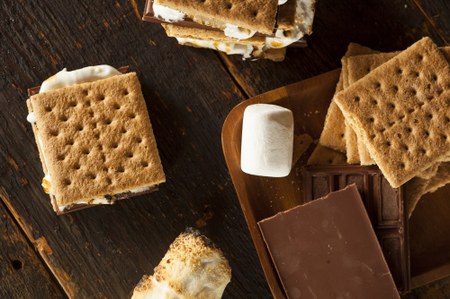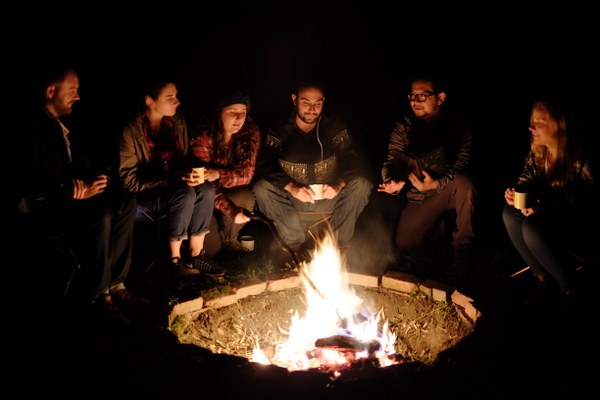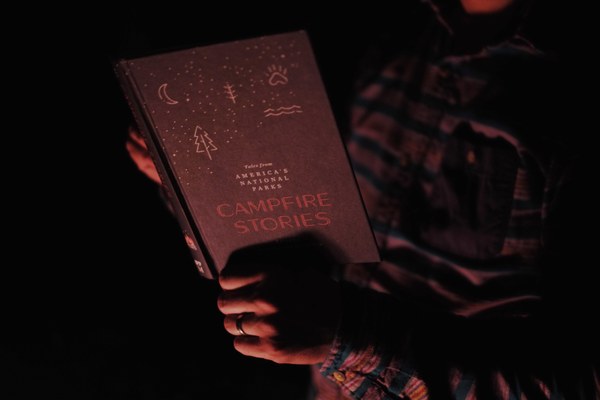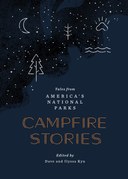
What could be better than sitting around a campfire with friends and family, telling stories and making s'mores? In the spirit of National S'mores Day, we caught up with Dave and Ilyssa Kyu, the editors behind Campfire Stories: Tales from America's National Parks, to ask them a few questions.
Tell us a little about your new book, Campfire Stories.
Campfire Stories is an anthology of tales, legends, ballads, songs, poems and short stories collected from six National Parks across the country. The stories are intended to reflect the essence of each place, while also reflecting the diverse voices of people past and present—to ensure all stories and histories of these lands are told.
Where did you get your inspiration for Campfire Stories?
It began around a campfire in Acadia National Park. We were sitting around a fire, and as conversation drew silent, Ilyssa found herself impulsively reaching for her phone, soon realizing the absurdity of it. Longing for stories to tell around a fire, as neither of us grew up camping or a knack for storytelling, our first stop was Amazon to find a book that had stories to read around a campfire. We soon realized there were mostly scary ghost stories—but we were more interested in learning about the places we were traveling to—the land, the people, the animals and its histories.
You spent months researching this collection, right? What was that experience like?
We knew that we would not be able to compile this collection of stories from afar—that we needed to travel to these places to talk to people, understand and learn more about each park, and then search for/collect the actual stories for the book. We spent a total of 5 months on the road researching the book—the first month we spent in Acadia to test and tweak our process before hitting the road months later for 4 months to the remaining 5 parks. When we hit the road for the longer trip, we camped and lived out of our car—traveling to and spending at least two weeks in each park. We got to meet all sorts of incredible people—park rangers, climbers, storytellers, chefs, business owners, lobstermen, farmers, tribal representatives, teachers and so on—and ask them what made their home so special and unique. We spent many hours digging through books, pamphlets, magazines, and binders in libraries and archives—reading, highlighting, post-it'ing and reading aloud the stories that best captured the themes and feelings of each place.
The experience was a rewarding and inspiring not just personally, but professionally. Ilyssa, as a design researcher and strategist (mostly working in the branding and digital realm), felt energized by the process of being able to interview somebody in person—then immediately taking what we learned in that conversation and chase that research to the other side of the island or the valley in a very tangible way. It was more personal, more immediate and beats doing a conference call or sitting at a computer all day, any day.

What was the most surprising thing you encountered?
The biggest surprise we had on the trip—though it had nothing to do with the trip—was that we learned three weeks into a four month trip that we were pregnant! In that, there were lots of things we learned, like how to eat healthy while on the road without refrigeration or what it's like to be living out of a tent during the first trimester of pregnancy (we won't repeat that again!).
Related to our book, we learned very early on in the process that you can't just roll into a town or park and say "Tell us your favorite story about this place." Though we're surrounded by and consume stories everyday through social media, TV, movies, radio, podcasts, and so on—we're increasingly disconnected from the stories about even the places we love. So we changed our process to use our interviews with folks in and around the park as a time to learn about these places and their connection to it—and started to create themes that collectively captured the essence of the park. We then used those themes to help guide us in finding and selecting stories from the various archives and libraries we visited while on the road!
If you had to choose the single most interesting person you met in your travels researching this book, who would it be?
There are too many interesting people to name! However, one notable person to highlight was Elmer Beal in Acadia National Park—who only agreed to do an interview if we gave him a ride home. Once a lobsterman, folk singer, and College of the Atlantic professor of anthropology, he has long owned and still runs an award-winning restaurant on the island called The Burning Tree, where he grows all of their salad greens out back and sources other ingredients from local farms. A character and storyteller himself, we learned a lot about the life of a lobsterman and Maine humor. It is a true pleasure to include Elmer's folk song "The Burning Tree," for which his restaurant is named after.
What were you looking for in a good national park story?
It was important the stories not only capture the essence of each park (based on our research) but also represent the diverse stories to be told about each place. Selecting a story based on who was telling the story was just as important as what the story was about, to ensure all voices were reflected in this book. We also tried to select stories that would appeal to a broader audience, as we hope this book is accessible to all—no matter your experience in the outdoors, age, or specific interests. And, also important—we tried to select stories that were entertaining and relevant for people today. With this in mind, we selected a variety of contemporary texts, adventure stories, and accounts of what it was like to visit these places for some of the parks earliest visitors—stories that would capture your listeners attention and imaginations.
With all the time you’ve spent around campfires, you must have consumed your fair share of s’mores. What’s your favorite way to enjoy this classic campfire treat?
One of our favorite decadent recipes is one that we call "the S'morgasm."
- Peel and then split a banana, and drop it into a aluminum foil boat.
- Drop mini marshmallows and mini chocolate chips into the center of the banana, and then roast the whole setup over your campfire, until the chocolate begins to melt.
- Once off the fire and cool enough to handle, you can use graham crackers to scoop out the gooey goodness!
But now with a toddler in the mix, we're eager to try out less messy recipes, and this has become our go-to:
- Drop mini marshmallows and mini chocolate chips into an ice cream cone, wrap with tinfoil, and toss directly in the fire.
- After a minute or two, remove with tongs, let cool, unwrap, and enjoy!
Mmm, sounds delicious! Thanks for stopping by, Dave and Ilyssa.
Learn More
Get your copy of Campfire Stories: Tales from America's National Parks, and meet Dave and Ilyssa in person by attending one of their upcoming talks.
 Mountaineers Books
Mountaineers Books

